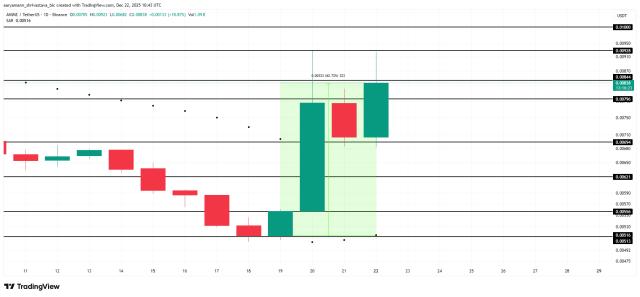Failed to buy the dips, and the market did not receive good news. Early this morning, the White House Press Secretary stated that the 104% additional tariffs on China have taken effect at noon Eastern Time, causing global financial markets to plummet again.
On April 3rd, when Trump's tariff policy was introduced, the U.S. Treasury Secretary Besson had suggested that no country should take retaliatory actions and wait until April 9th to see if any negotiations would occur. There was even another "fake news" drama, hoping that Trump might be willing to negotiate trade barriers for multiple countries and specific products, leading to a rebound that would temporarily revive global capital markets.
Related reading: 《CNBC Guest's Verbal Slip Brews $3 Trillion "Tariff Blunder Case", Becoming the Most Absurd 10 Minutes in Financial History》
After several days of gaming, the market did not receive good news. From 10% at the beginning of the year to 20% in March, and then 34% in early April, now with a 50% "retaliatory escalation", the China-US trade friction has escalated into an "economic nuclear war".
Will the stock market be able to withstand another China-US trade war?
Since the Trump administration announced a new round of tariff policies last week, international capital markets have experienced severe shocks, with the U.S. stock market being the first to be hit. As of the close of trading this Tuesday, the S&P 500 index broke below 5,000 points for the first time in nearly a year, with a cumulative decline of 18.9% from its February 19th high point, just a step away from the 20% drop threshold of a "technical bear market". It is estimated that the market value of S&P 500 index components evaporated by $5.8 trillion in four trading days, creating the most severe four-day consecutive decline record since the index was established in the 1950s.
Meanwhile, the U.S. tariff policy has triggered a chain reaction in global capital markets. Bloomberg statistics show that since Trump proposed the so-called "reciprocal tariffs" on April 3rd, the total market value of global stocks has shrunk by $10 trillion, slightly more than half of the EU's GDP. U.S. tech giants have been hit hard, with the market value of seven major tech companies, including Apple and Microsoft, evaporating by $1.65 trillion. Apple, highly dependent on overseas supply chains, saw its stock price plummet nearly 23% in four days, creating the largest single-week decline since the COVID-19 outbreak in 2020.
Previously, many opinion leaders in the crypto circle believed that crypto assets would not be affected by traditional tariffs because their transactions do not require crossing borders or customs. They believed that in an era of new mercantilism and trade barriers, the value proposition of cryptocurrencies would become more prominent. Strategy founder Michael Saylor wrote on April 3rd, "Bitcoin has no tariffs."
However, the total market value of cryptocurrencies has fallen 35% from its peak in December 2024, dropping from $3.9 trillion to $2.5 trillion. The "Crypto Fear and Greed Index" shows 17, indicating an extremely panicked market sentiment.
Last night, Bitcoin once again fell below $75,000. Meanwhile, BTC's market dominance continued to rise, and the Altcoin market looked miserable, with Ethereum falling below $1,400 again.
In the past 12 hours, the crypto market has liquidated a total of $243 million, including $192 million in long liquidations and $51.03 million in short liquidations.
The continued decline in Bitcoin prices may even force Strategy, which has been consistently buying, to sell Bitcoin. According to the 8-K form submitted by Strategy to the SEC on April 7th, if Bitcoin prices continue to fall, Strategy may be forced to sell its Bitcoin holdings to repay debt, breaking Michael Saylor's promise to "never sell Bitcoin".
Since Trump won the election in November 2024, Strategy has bought 275,965 BTC at an average price of $93,228 (worth $25.73 billion), and this portion has already suffered an unrealized loss of $4.6 billion.
Pessimistic expectations are intensifying. How do analysts view the current market?
Over the past week, multiple Wall Street banks, including Goldman Sachs and JPMorgan, have warned that if the trade war continues to escalate, the U.S. and global economies may fall into recession this year, further weakening the attractiveness of financial markets.
However, the White House team is celebrating victory. "We are bottoming out now, really bottoming out," Trump's chief trade advisor Peter Navarro said on Fox News on Monday night. "Next will be a reversal, and those companies in the S&P 500 that first bring production back to the U.S. will drive the recovery, and this will happen soon. Dow 50,000, I guarantee it, and there won't be a recession."
However, Navarro's optimistic remarks were not endorsed by JPMorgan CEO Jamie Dimon, who warned in his annual letter to shareholders on Monday that Trump's tariffs would drive up prices, drag down the global economy, and weaken the U.S.'s global status by disrupting its alliance system. Even some of Trump's allies, including Elon Musk and Bill Ackman, have recently warned that this tariff policy has serious logical flaws and is the wrong approach.
Related reading: 《After the Financial Market Bloodbath, How Do Wall Street Bigwigs View Trump's Tariff Policy?》
Crypto analyst Phyrex believes that from the Federal Reserve's behavioral logic, unless inflation clearly falls, even a "defensive rate cut" would be difficult to implement quickly. The real watershed might be when the U.S. GDP data is released at the end of April.
From the crypto market perspective, BTC's turnover rate dropped today. URPD data shows that even when the price fell below $77,000, investors in the 93,000-98,000 range hardly reduced positions, indicating that the current selling pressure does not come from high-position holders. The top has not seen panic selling, and the on-chain structure remains relatively healthy. As long as subsequent policies do not frequently fluctuate, BTC and risk markets may still have room for a staged recovery.
As U.S. Treasury bonds no longer play the role of a safe haven, the 10-year Treasury yield has risen to around 4.3%, higher than the end of March, pushing up the cost of mortgage and other types of loans. The 30-year Treasury yield closed at 4.76%, rising nearly half a percentage point from Monday's lowest point. The yield curve spread between U.S. two-year and ten-year Treasury bonds widened to 48 basis points, the steepest level since May 2022.
BitMEX co-founder Arthur Hayes wrote that "the Federal Reserve is running out of time, and the situation is getting out of control. Previously, stock market declines would cause U.S. 10-year Treasury yields to fall, which was beneficial to risk assets. Now, the stock market decline is accompanied by rising U.S. 10-year Treasury yields, which is bad. The market finally realizes that if U.S. dollar export income decreases, there can be no more buying of Treasury bonds or stocks. The game is over."
Pessimistic expectations are strengthening. Trader Eugene wrote that "the introduction of global trade tariffs marks a change in world order unseen in over 50 years. Free trade has always been a key factor driving productivity and economic growth, enabling the largest long-term bull market in history. Shifting from openness to protectionism will have far-reaching impacts that will take years to gradually emerge, unless Trump completely abandons his tariff plans. I believe this possibility is very low. This will pose significant long-term resistance to global risk assets."
In the cryptocurrency sector, the recent structural decline in active developers might be the most concerning issue. In the previous cycle, we could observe developer activity and feel reassured, knowing our industry still benefited from long-term tailwinds. Fast forward 2-3 years, we have not only failed to produce anything particularly interesting or important, but the future prospects are even worse than before.
In the previous cycle, we looked forward to the launch of ETFs and a better regulatory environment under crypto-supportive government leadership as a glimmer of hope at the end of the tunnel. Now that these have been realized, they (once again) failed to meet expectations. I cannot see anything that could help cryptocurrencies escape their inherent "Ouroboros" (self-cyclical, self-consuming dilemma).
From a more macro perspective, the world is experiencing an unprecedented transformation. Billionaire hedge fund manager and Bridgewater founder Ray Dalio wrote that while the market and economic focus on tariffs is important, deeper global issues should not be overlooked. He pointed out that we are in a "classic collapse" stage of monetary, political, and geopolitical order - a situation that might occur only once in a lifetime, but has happened multiple times in history.
Dalio suggested not being distracted by short-term events like tariffs, but focusing on the interaction of five forces (economic, political, geopolitical, natural, and technological). Studying similar historical cycles (such as monetary crises) can help predict the future.
"The current changes are part of a historic large cycle. Tariffs are just a surface phenomenon. The real driving forces are the structural collapse of monetary, political, and geopolitical orders. Understanding the interaction of these forces and learning from historical experiences is key to better facing the future."
Welcome to join BlockBeats official community:
Telegram Subscription Group: https://t.me/theblockbeats
Telegram Communication Group: https://t.me/BlockBeats_App
Official Twitter Account: https://twitter.com/BlockBeatsAsia







